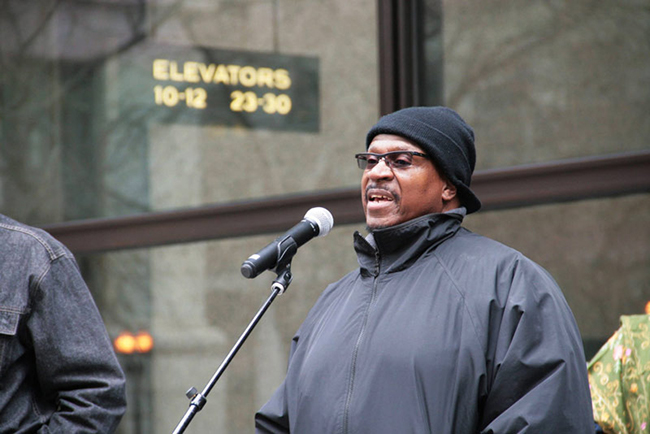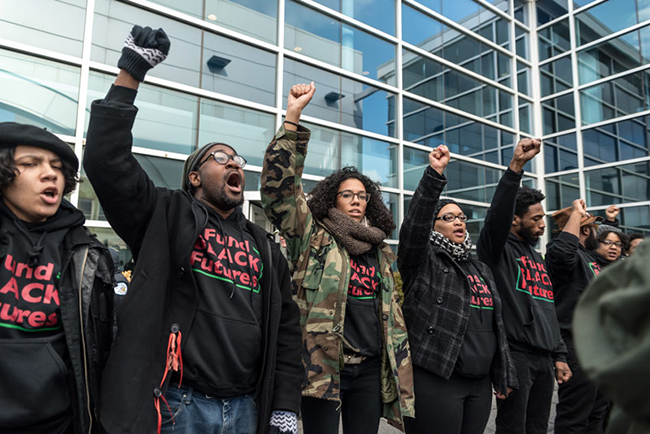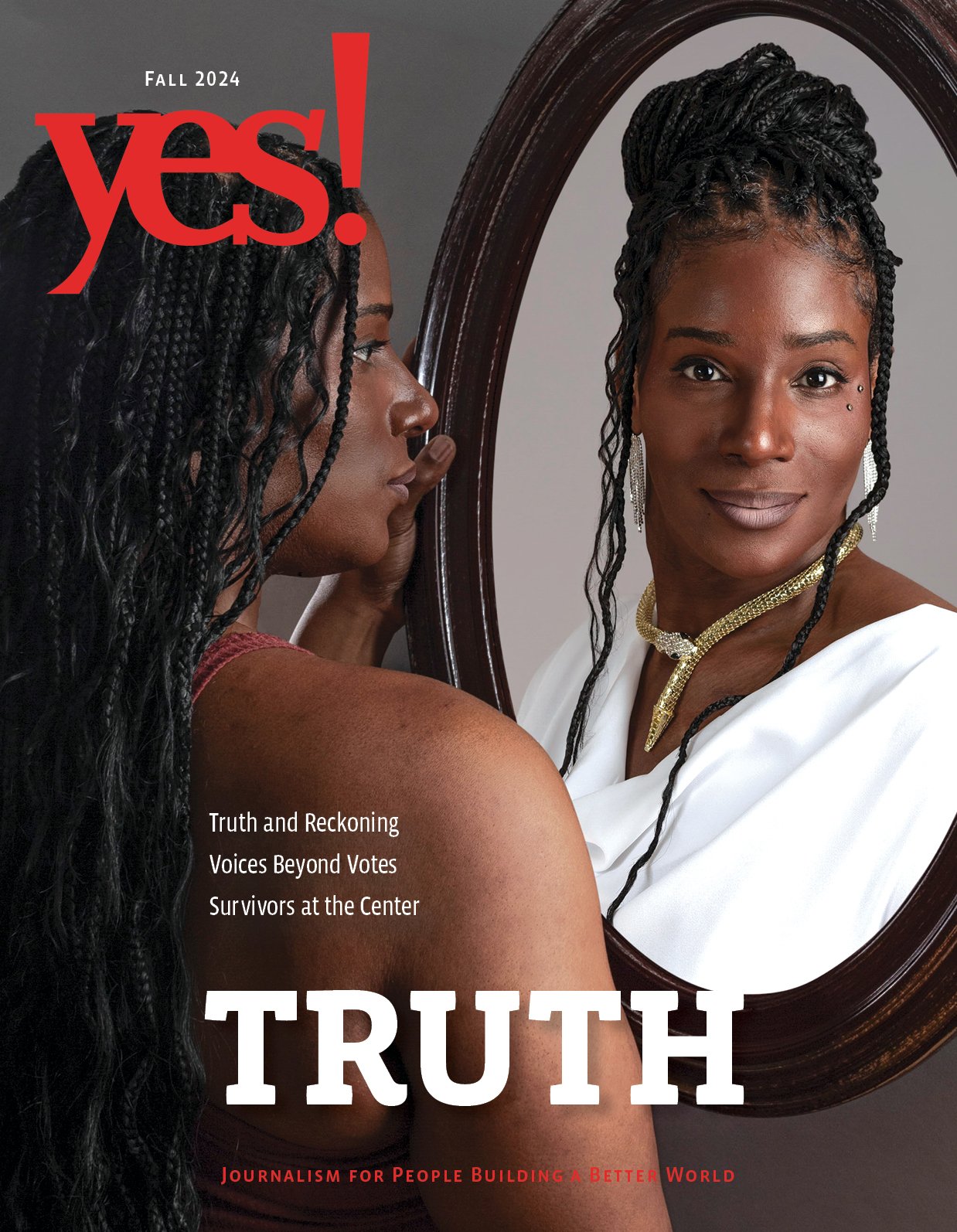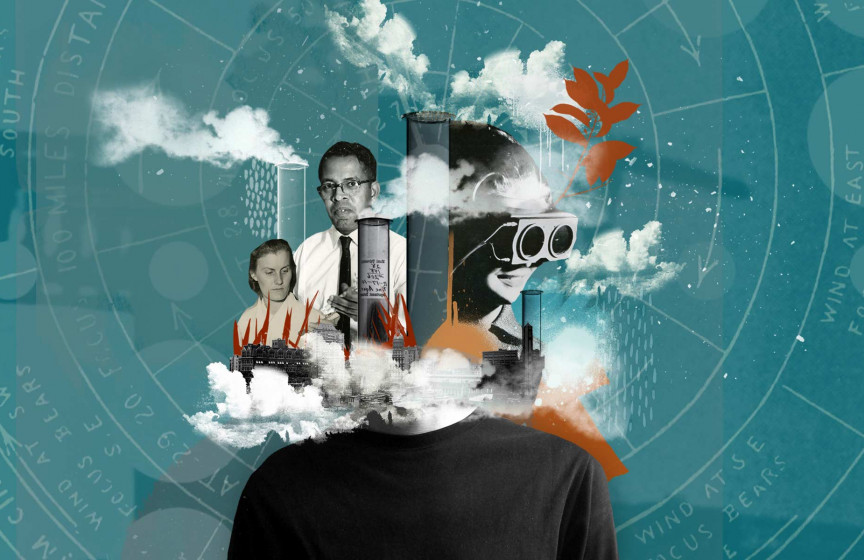Why Science Can’t Be Silent: Solutions We Love
- How Chicago Became the First City to Make Reparations to Victims of Police Violence
- Share

Activists block a road in Chicago in an attempt to shut down the International Association of Chiefs of Police Conference in 2015. Photo by Sarah-Ji.
How Chicago Became the First City to Make Reparations to Victims of Police Violence
The ordinance provides a meaningful model for creating reparations at the local level.
Somewhere between his 12th and 13th hour inside a Chicago Police Department interrogation room, Lindsey Smith decided to confess to a murder he didn’t commit. Multiple officers had pistol-whipped, stomped on, and beaten him, again and again. Convinced he would not otherwise live through the ordeal, Smith signed a false confession for the attempted murder of a 12-year-old White boy. At 17, Smith too was a boy. But with one major difference: He was Black.
Tried as an adult and convicted, Smith took a plea deal and served nearly five years in prison.
He was among the first of at least 120 young, primarily Black men whom Chicago police officers would torture into false confessions. Yet while many who suffer at the hands of the police never get justice, Smith’s story ended differently. More than 40 years later, following the passage of historic reparations legislation, he became one of the first Black people in America to be granted reparations for racial violence.
After receiving parole, Smith moved out of the city and attempted to rebuild his life. But his struggles were far from over. Given the conviction on his record, Smith faced difficulty in everything from finding work to accessing his car insurance benefits. He remained haunted by his experiences as a teen inside the interrogation room and never felt at ease in Chicago again—until May 6, 2015.
On that date, the city of Chicago signed into law an ordinance granting cash payments, free college education, and a range of social services to 57 living survivors of police torture. Explicitly defined as reparations, the ordinance also includes a formal apology from Mayor Rahm Emanuel and a mandate to teach the broader public about the torture through a memorial and public schools curriculum. The hard-won legislation, envisioned by activists, made Chicago the first, and thus far only, municipality in the country to pay reparations for racist police violence.
Reparations have found a renewed life in American public discourse and at the heart of some social movements.
“I can sleep a whole lot better tonight,” Smith told local media upon the ordinance’s passage. A 61-year-old factory worker, he has since collected $100,000 in reparations.
“I’d take that night back before I took their money any day. I can never get back that time away from my family and the things I could have done,” Smith said. “But at least I can afford new shoes now.”
As the national conversation around racial disparities in the United States has broadened to include criminalization, job discrimination, school segregation, and neglect of infrastructure, so has the need for a reckoning of the institutional wrongs done to African American communities. Reparations, the concept of offering monetary or social redress for historical injustices, has found a renewed life in American public discourse and at the heart of some social movements.
With the election of Donald Trump, it seems unlikely that reparations will move forward at a national scale anytime soon. But Chicago’s ordinance provides a model for creating reparations at the local level, even in the face of daunting circumstances.
The momentum has been building for years. Reparations sparked debate on the presidential campaign trail, and when more than 50 organizations collaborated to write the Movement for Black Lives policy platform earlier this year, they put reparations front and center.
“We wanted to put forth a set of policies that show what we really want and what would lead to a transformation of our conditions,” says Karl Kumodzi, a member of the coalition’s policy table who is active with the organizations BlackBird and Black Youth Project 100 in Brooklyn, New York. “Reparations had to be at the forefront of that.”
Since then, a Georgetown University committee has recognized that the school profited from the sale of slaves and said it would “reconcile” by naming two buildings after African Americans and by offering preferred admission status to any descendants of slaves who worked at the university.
Increasingly, the question appears not to be whether reparations are needed, but in what form and how to get them.
Most of the time, it’s still an abstract conversation. But Chicago’s $5.5 million reparations legislation is a concrete exception.
According to a city spokesperson, as of October, payments have been made to the majority of the 57 recognized survivors, nine individuals have begun the process of accessing free community college, and 11 requests for prioritized access to social services have been made. Meanwhile, a city-funded community center dedicated to survivors and their families is set to open later this year, when curriculum on the torture scandal will commence in Chicago Public Schools.

Torture survivor Anthony Holmes speaks at an Amnesty International rally in Chicago. Photo by Scott Langley/Amnesty International.
From the Black Manifesto to the Movement for Black Lives
Mary Frances Berry, a former chairperson of the U.S. Civil Rights Commission, documented the country’s first struggle for reparations, which was led by ex-slaves, in her book My Face Is Black Is True. She thinks Chicago offers a model for how to win reparations across the country.
“We often hear talk about national legislation and national responses in the civil rights community. … But a lot of things can be done locally,” she says. “Chicago shows [what] can be done—and [that] other kinds of remedies for other kinds of harms can be done, like, for example, the harm done to the people in Flint.”
Berry was referencing the ongoing water crisis in Flint, Michigan, that left thousands of residents in the predominantly African American town without access to clean drinking water.
Not far from Flint, nearly 50 years ago, the Black Manifesto was launched in Detroit as one of the first calls for reparations in the modern era. Penned by James Forman, a former organizer with the Student Nonviolent Coordinating Committee, and released at the 1969 National Black Economic Development Conference, the manifesto demanded $500 million in reparations from predominantly White religious institutions for their historic role in perpetuating slavery. The manifesto demanded that the money fund nine key projects aimed at building the collective wealth of Black communities: a Black university, Black presses and broadcast networks, research and training centers, and a Southern land bank. A multiracial contingent of clergy in support of the Black Manifesto succeeded in raising at least $215,000 from the Episcopalian and Methodist churches through months of rancorous deliberation that ultimately tore the coalition apart.
The mantle was next assumed by the National Coalition of Blacks for Reparations in America, or N’COBRA. Centering their demands on reparations for chattel slavery, N’COBRA gained a following throughout the early 1990s, but their demands never established a mainstream foothold.
There are three key components to a reparations program: acknowledgement, restitution, and closure.
Joe Feagin, distinguished professor of sociology at Texas A&M University, has a hunch about why that is. It has been difficult for demands for reparations for slavery to gain traction in the past, he says, because the direct link between slavery and the high rates of poverty prevalent in contemporary Black communities is not widely understood, let alone acknowledged.
“When you focus on slavery, it’s easy for Whites to say all the Whites are dead and all the Blacks are dead,” Feagin said.
But that’s not true for Jim Crow segregation, Feagin pointed out, citing a study on “segregation stress syndrome” based on interviews with 100 elderly African Americans in the South. The study revealed that 80 percent of the participants’ families had suffered extreme violence in the form of lynching, rape, attempted rape, and home invasions. “They can name the White families who were involved,” Feagin said.
But with the publication of Ta-Nehisi Coates’ landmark article “The Case for Reparations,” in 2014, the living legacy of White supremacy became difficult to deny. Detailing the systematic “plunder” of Black communities, Coates’ work tracks multiple Chicagoans living the outcomes of generations of racism—demonstrating a legacy of impoverishment that runs from slavery, sharecropping, and Jim Crow to housing discrimination and economic hardship today.
As for solutions, Coates called for support of H.R. 40, federal legislation that seeks to form a commission on reparations. Sponsored by John Conyers, D-Mich., ranking member of the House Judiciary Committee and a founding member of the Congressional Black Caucus, H.R. 40 aims “to examine the institution of slavery and its legacy, like racial disparities in education, housing, and healthcare” and then “recommend appropriate remedies to Congress.” First introduced in 1989, H.R. 40 has been reintroduced by Conyers in every session of Congress since—and subsequently mired in the House of Representatives’ Subcommittee on the Constitution and Civil Justice, currently chaired by Trent Franks, R-Ariz.
But although H.R. 40 has languished, other reparations legislation has prevailed at both the state and federal levels. In 1988, President Ronald Reagan signed a bill providing $20,000 to each of the approximately 65,000 living Japanese Americans who had been interned during World War II, prompting Congress to allocate $1.25 billion. A few years later, the state of Florida approved $2.1 million for the living survivors of a 1923 racial pogrom that resulted in multiple deaths and the decimation of the Black community in the town of Rosewood.
More recently, in 2014, the state of North Carolina set aside $10 million for reparations payments to living survivors of the state’s eugenics program, which forcibly sterilized approximately 7,600 people. Last year, the state of Virginia, one of more than 30 other states that practiced forced sterilizations, followed North Carolina’s lead and will soon begin awarding $25,000 to each survivor.
Meanwhile, the five-point outline for reparations in the Movement for Black Lives platform broadens the conversation. Spanning a demand for services focused on healing from trauma to access to free education and cash support in the form of a “guaranteed livable income,” the policy platform was built on decades of experience, research, and values long held by the Black radical tradition—galvanized further by the victory in Chicago, says Kumodzi.
“What they won offers clear examples of reparations being more than just a check, but rather a set of initiatives and investments that address the economic, psychological, educational, and health impacts of the harm that’s been done,” Kumodzi says.
How they did it
So how’d they do it?
According to sociologist Tressie McMillan Cottom, there are three key components to a reparations program: acknowledgement, restitution, and closure. In addition, for an offered recompense to be reparations, it must be specific to alleviating or directing resources at the harm caused.
In many ways, the movement for reparations in Chicago started out of a lack of acknowledgement. Communities in Chicago had spent years fighting for legal redress for survivors of police torture under Commander Jon Burge and his officers, who for nearly three decades tortured more than 120 Black and Latino men into confessing to crimes they didn’t commit.
Their first effort was legal: to bring the weight of the law against Jon Burge and officers under his command and to achieve retrials for the wrongfully convicted people still imprisoned. The statute of limitations had expired on many of the alleged cases of police torture, but Burge was eventually brought to trial and sentenced for perjury.
Attorney Joey Mogul had been litigating cases on behalf of people who claimed to be victims of Burge’s torture squad for more than two decades by the time the commander was brought into court. But looking around at the torture survivors she had been working with, especially those asked to dredge up painful memories for Burge’s trial, Mogul realized the victory of his conviction for perjury and obstruction of justice was a hollow one.
“What we gained, what we won, was more expansive than any court could have provided.”
“It didn’t bring them peace or relief,” she said. She points to the case of Anthony Holmes, who said he was tortured by officers under Burge in 1973 and went on to serve the full 33-and-a-half-year sentence for murder before being exonerated. “Anthony Holmes … struggles with trauma to this day. There [were] no psychological services for him whatsoever.”
Mogul and Alice Kim, an activist whose work amplifying the voices of Burge victims on death row was instrumental in winning a moratorium in Illinois, started the Chicago Torture Justice Memorials along with several others. From there grew the idea of a city ordinance as a way to recognize the city’s legacy of torture.
The ordinance was drafted in 2012 and included a request for financial compensation, as well as a curriculum to teach about the Burge tortures in Chicago Public Schools and free enrollment in the city’s community colleges.
Then, in October 2013, following the city’s settlement with two police torture victims, Rahm Emanuel attempted to close the book on the issue by urging Chicago to “all move on.” That spurred outrage—and an increased urgency to push the ordinance before the City Council.
The group found an alderman friendly with the mayor to bring it into committee. At the same time, a coalition was forming that would bring the burgeoning power of the Black Lives Matter movement to the fight for reparations. The next year, the group upped its efforts, ranging from protests to meetings with city officials. After decades of organizing around the Burge tortures, the ordinance passed in the spring.
“We fought outside the legal box,” said Mogul. “What we gained, what we won, was more expansive than any court could have provided.”
In January 2016, the checks to individual torture victims went into the mail. The city has agreed to provide three additional years of funding while the curriculum and memorial planning are underway.
However, the ordinance limits financial relief to people tortured during Burge’s exact time on the force—from May 1, 1972 to Nov. 30, 1991—despite evidence that it continued after he left. More than 20 known Burge survivors remain incarcerated today, according to lawyers with the reparations committee.
For the Chicago Torture Justice Memorials team, the gains of reparations serve as a starting point and reminder of all there is to be done.
“The glass is only half full because until we get those other brothers back to court and get fair and impartial hearings into their allegations of having been tortured, then this fight must continue” said Darrell Cannon, a survivor of Burge’s police torture.

Organizers shut down business at the Fraternal Order of Polices bank in January 2016 demanding that the city divest from the police and instead #BuildBlackFutures. Photo by Sarah-Ji.
Moving forward
Aislinn Pulley, a co-founder of Black Lives Matter Chicago, considers the city’s effort one of the most powerful examples of reparations. “Chicago … created new possibilities of what transformative justice, holistic justice can look like and, in addressing the modern problems of policing, helps us envision new demands and possibilities of justice,” she said.
What’s more, activists like Janaé Bonsu, who worked on the reparations campaign, have taken their experience in Chicago and run with it. As national public policy chair of Black Youth Project 100, she has fought in recent months to keep open the historically Black Chicago State University in Illinois and to partially “defund the police” in municipal budgets nationwide, advocating for the funding of programs benefitting Black communities in need of services instead.
Bonsu sees clear next steps for where the fight for reparations needs to move. “I think the conversation of reparations should be expanded to thinking about the war on drugs, in thinking about [housing] redline policies—in all the ways systemic racism can be proved,” said Bonsu.
The story of Chicago’s ordinance suggests that local campaigns have the potential to broaden reparations in each of these ways. But in the absence of a national policy, how much harm can be mitigated by local laws? If hundreds of Chicago-style ordinances were replicated in every town or state where demonstrable, systemic harm can be proved, how far would they go in addressing centuries of wrong meted out by the state against African Americans and other vulnerable communities?
The state and city levels can be a powerful means for keeping the larger dream of national reparations alive.
Kumodzi says that reparations are needed on multiple fronts: for both specific harms, such as those wrought by Chicago’s police torture ring, and oppressive systems as a whole. There needs to be an analysis of reparations, not just for very specific cases that require proof, but also for the intergenerational, community-wide, and lasting impacts of systems like slavery and policing. “They also have the same consequences, the same needs of their families, the same lasting traumatic effects.”
However, under a Trump presidency, Kumodzi says, priorities in organizing will shift because conditions have shifted: The state and city levels can be a powerful means for keeping the larger dream of national reparations alive.
“Our vision for the world that we want to live in, our demands, our understanding of the policies that are going to get us towards that vision, that’s not going to change, that’s gonna stay the same for the long haul—whether it’s four years, two years, 10 years,” he said. “There’s been a lot of harms. Reparations have to be done to address those harms.”

